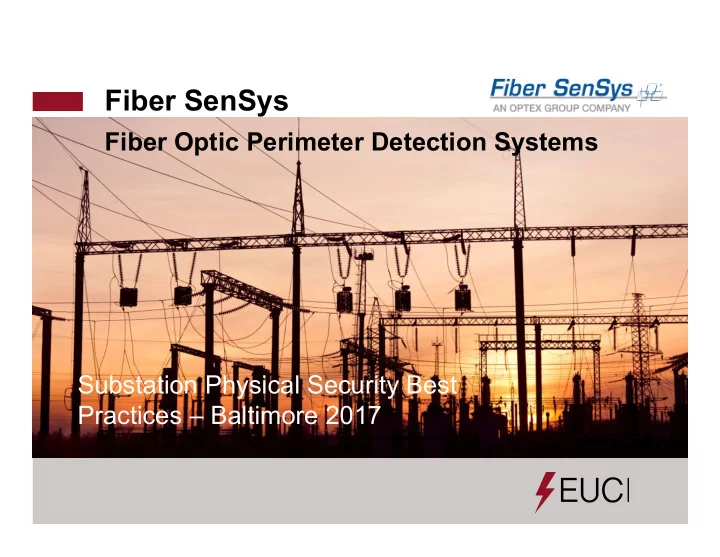

Fiber SenSys Fiber Optic Perimeter Detection Systems Substation Physical Security Best Practices – Baltimore 2017
Detection Sensor Deployment Options for Various Substation Barrier Systems Rod Hurley North American Sales Manager Eastern Region Sales Manager Fiber SenSys, Inc. (800) 641-8150 Toll Free PA Office 717-235-3625 Office 503-701-6658 Cell rod.hurley@fibersensys.com www.fibersensys.com
Objective • Each application dictates the appropriate barrier and detection system selection. • The objective of this presentation is to provide guidance for the application of fiber optic sensor on the most commonly- encountered barrier variations.
Barrier Variations • Chain-Link • Steel Pales, Pickets • Welded Mesh • Anti-Climb Fabrics • Expanded Metal • C-Wire, Razor Ribbon • Walls and Wall Tops • Wrought Iron
Fiber Optic Detection System Diagram
Fiber Optic Sensor – Theory of Operation • The multiple modes of light found in multimode fiber form a random- intensity pattern known as a “speckle pattern.” The speckle pattern remains relatively constant and stationary if the fiber is undisturbed. • However, when the fiber is disturbed due to motion, vibration, or pressure, the alarm processor witnesses a change in the speckle pattern and is designed to determine what the nature of the event is.
Theory of Operation (cont.) • Very small changes in the multimode speckle pattern are detected and analyzed by the system’s digital signal processors
General Sensor Guidelines • Apply sensor based on the threat(s) – Cut/Penetration: lower sensor run – Scaling and climb-over: all sensor runs – Ladder-assisted climb-over: upper sensor run
Sensor Location Guidelines • Install sensor on the secure side of the barrier (inside of the outer fence fabric) • Install sensor as close as possible to expected point of impact with the barrier – You want to use the minimal amount of “gain” or “sensitivity” to obtain the desired PoD. This minimizes NAR.
Sensor Location Guidelines (cont.) • Accommodate coexistence on the barrier with other systems and infrastructure. • Be mindful of vulnerability to vandalism/attack and maintainability when locating sensor.
Examples of Barrier Variations
Galvanized Chain Link Fence
Vinyl-Coated Chain Link Fence
Climb-Resistant Chain Link Mini-Mesh
Welded Mesh Fence
Rigid Fence with Anti-Climb Fabric
Steel Pale Barrier
Concrete Wall
Masonry Wall
Fence Barriers • Attach sensor (in flexible conduit) using stainless steel ties every one foot of sensor. • Use two runs of sensor for the first eight feet of fence height for chain link, welded mesh, and expanded metal fabrics. • Add a run of sensor for each additional four feet of fence height.
Sensor Attached to Chain Link Fence
Sensor Attached to Expanded Metal Fabric
11 ft. Tall Fence With 3 Sensor Runs
Fence Barriers • Install additional sensor for reinforced panels, along pull posts, and for service loops. • Within a detection zone, the barrier structure must be homogeneous. Do not combine different fence types such as chain link and expanded metal within a zone.
Add Sensor at Reinforced Fence Panels
Service Loops
Fence Barriers • Keep in mind that the more rigid the structure, the smaller the propagation of vibrations.
Rigid Metal Panel Barrier • Sensor is most often attached to the fence. • Sensor may be installed in the fence, but this must occur in conjunction with the fence construction.
Sensor Attached to Barrier
Sensor in the Rails
Steel Pale/Picket/Ornamental Barriers • Run sensor along rails (horizontal members) or inside of rails
Sensor Installed in Steel Pale Barrier
Sensor Installed in Rail Using Clips
Sensor Attached to Ornamental Fence
Detection in Top Guard Obstacle • PL-1 military-style configuration – Top run of sensor extends to cover outriggers • Separate detection zones for sensor run in top guard obstacles
MIL Sensor Configuration
Sensor Attachment in Razor Ribbon
Sensor Installed in Top Guard
Walls • Penetration detection – Sensor mounted to the secure side of wall in a “serpentine” pattern • Climb-over detection – Sensor in top guard or on outriggers – Sensor on stand-offs to detect hand-hold or foot-hold attempts
Masonry Wall-Mounted Sensor
Sensor on Reinforced Concrete Block
Sensor with Wall Top Outriggers
Wall Top Sensor on Stand-Offs
Masonry Wall with Sensor on Stand-Offs
Gates • Sensor can be installed on swing-type gates, crossing the hinge at a diagonal to prevent kinking of the sensor • Use a cable trolley system or separate motion sensor to protect sliding gate areas
Double Leaf Swing Gate
Cable “Trolley” System for Sliding Gate
Other Concerns • Loose fence fabric or components • Loose signage • Conduits run along interior of the barrier • Drainage culverts • Vegetation and overhanging tree branches • Wildlife • Weather • Testing Methods
Sensor Woven in Culvert Grating
Testing Methods
Expanded Metal and Welded Mesh
Sound-Dampening Panel
Perimeter Security Today, it’s more than just a fence.
Recommend
More recommend